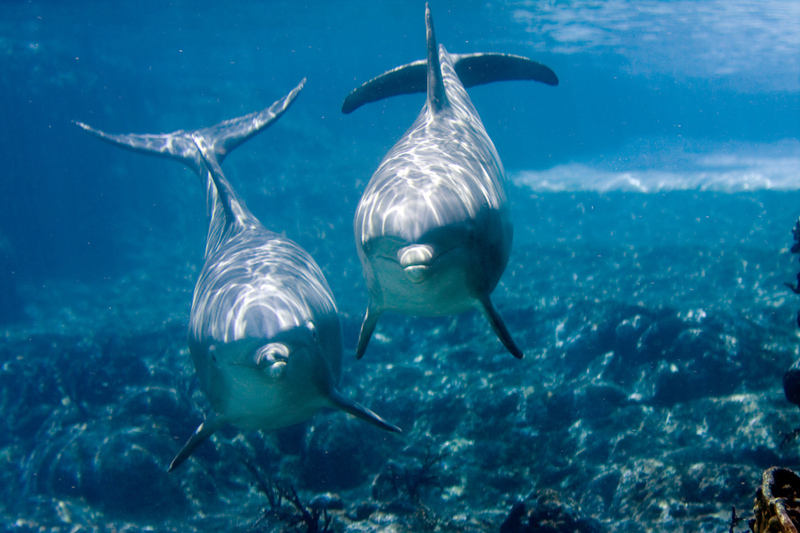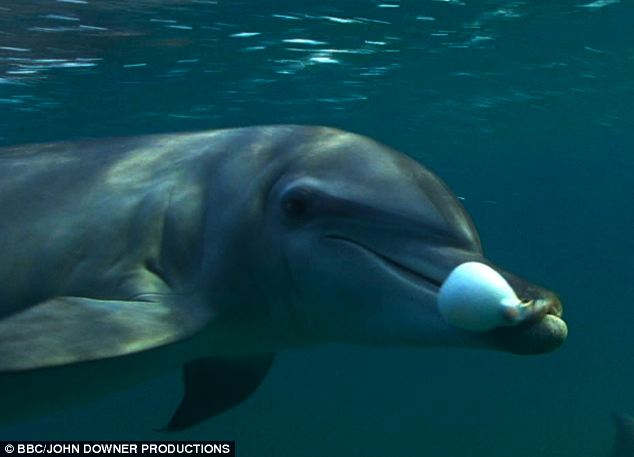
Do Stoned Dolphins Give ‘Puff Puff Pass’ A Whole New Meaning?


This Thursday, the BBC will air an intriguing new underwater documentary titled Dolphins: Spy in the Pod, which features footage captured by cleverly disguised cameras to observe dolphins in their natural environment. While the series promises rare insights into the daily lives of these intelligent marine mammals, one particular scene has made headlines even before its official release.
According to The Sunday Times, the documentary includes footage that appears to show dolphins intentionally interacting with pufferfish in a peculiar way—suggesting they may be using the fish to get intoxicated. The scene reportedly captures young dolphins gently harassing a pufferfish and then passing it around among themselves. Shortly after, the dolphins enter what’s described as a “trance-like state,” appearing mesmerized as they hover near the surface, staring at their reflections.
“This was a case of young dolphins purposefully experimenting with something we know to be intoxicating,” said zoologist Rob Pilley, one of the documentary’s producers. He described the dolphins’ behavior as highly unusual and suggested it could indicate purposeful drug-like experimentation.
The notion that dolphins could be engaging in recreational drug use is certainly attention-grabbing—and entertaining. After all, dolphins are already known for complex social behavior, intelligence, and a somewhat dark moral record, which includes documented cases of bullying, infanticide, and even sexual aggression. If true, recreational drug use would simply be the latest addition to the list of their surprisingly human-like behaviors.
But Is It Really True?
As fascinating as it sounds, many scientists and skeptics aren't convinced. While dolphins are indeed curious and intelligent creatures—capable of exploring and manipulating unfamiliar objects—the idea that they intentionally use a toxic fish as a drug source is, at best, speculative.
Let’s break it down: When threatened, pufferfish can inflate their bodies as a defense mechanism, making them harder to eat. If that fails, they produce a powerful neurotoxin called tetrodotoxin (TTX), which serves as a chemical deterrent. TTX is incredibly potent, even in minuscule doses. It’s the same substance responsible for occasional fatalities among diners who consume poorly prepared fugu, the Japanese delicacy made from pufferfish.
The theory presented in the documentary suggests that dolphins are purposefully provoking the fish to release just enough toxin to get a mild “buzz.” However, this raises numerous scientific red flags.
Tetrodotoxin: A High-Risk Substance
Tetrodotoxin doesn’t function like typical recreational drugs. It doesn’t cross the blood-brain barrier, which means it doesn’t cause the type of mental or emotional alterations typically associated with substances like THC or MDMA. Instead, TTX acts on the nervous system by blocking sodium channels, silencing neural communication. In very small amounts, it may cause tingling or numbness. In higher doses, it leads to paralysis, respiratory failure, and death.
So why would dolphins risk exposure to such a substance? There’s little evidence that TTX causes euphoria or pleasurable effects at any dose. If it did, humans—ever eager to exploit new substances—would likely have found a way to use it recreationally. But even in Japan, where pufferfish has been consumed for centuries, the goal is to avoid toxic effects, not seek them.
From 1974 to 1983, tetrodotoxin poisoning killed 179 people and poisoned nearly 500 more in Japan alone. Gram for gram, TTX is 120,000 times more lethal than cocaine, and tens of thousands of times more deadly than heroin or methamphetamine. It’s even more toxic than the venom of the black mamba or widow spiders. There’s simply nothing “fun” about it—it's a chemical weapon, not a recreational tool.
What Was Really Caught on Camera?
Could the dolphins simply have been curious, and accidentally experienced a mild dose of TTX? That seems far more plausible. Dolphins often interact playfully—and sometimes aggressively—with various marine creatures. They could easily mistake a pufferfish for a toy or test its texture and behavior out of curiosity.
In the BBC footage, the dolphins’ behavior—such as staying near the surface and appearing dazed—could just as easily be early signs of toxin exposure. Rather than intoxication, these behaviors might reflect physical discomfort, paralysis, or instinctive survival responses, like staying near the surface to breathe more easily. It's worth noting that different pufferfish carry varying levels of toxin, making the whole idea of using them for a controlled “high” highly impractical and risky.
A Dangerous Game
If dolphins were deliberately using pufferfish for intoxication, it would mean they’re treading a razor-thin line between mild numbness and full-body paralysis. Given the inconsistent toxicity levels among puffers, it’s hard to believe that even the smartest dolphins could accurately manage that risk repeatedly. One miscalculation could be fatal.
Some scientists believe the dolphins’ odd behavior may be better explained as a naïve mistake—young males experimenting with a strange creature and suffering unintended consequences. The fact that they were filmed behaving strangely after the encounter doesn’t necessarily point to drug use; it could just as easily indicate the onset of mild poisoning.
Could There Be More to the Story?
Still, the idea isn’t entirely without scientific value. As someone who studies toxins and chemical ecology, I can’t help but wonder: if dolphins really were experimenting with toxins, what does that say about intelligence, risk, and evolution in animal behavior?
Very few examples of recreational drug use exist in the wild. Some animals eat fermented fruit or lick hallucinogenic toads, but these behaviors are rare and poorly understood. If dolphins were using tetrodotoxin recreationally, it would be one of the most bizarre and dangerous examples ever recorded—and it would raise countless questions about how and why such behavior might evolve.
How would such interactions influence the evolution of toxins in pufferfish? Could they affect dolphin health or behavior long-term? Could dolphins learn to self-medicate or regulate their experiences with toxic substances in a purposeful way?
These are fascinating questions—but right now, they remain hypothetical.
In Conclusion
The idea of dolphins getting high off pufferfish is wildly entertaining, and it certainly makes for good television. But from a scientific standpoint, there’s little credible evidence to suggest intentional drug use. More likely, this was a case of animal curiosity gone slightly wrong—a group of young dolphins pushing the boundaries of play, perhaps suffering temporary consequences, and living to swim another day.
That said, if dolphins are getting high, someone should really just pass Flipper a joint and let the poor guy relax without the risk of neurotoxin-induced paralysis.
News in the same category


What Is the Longest River in the World? Top 5 Longest Rivers

The Monster Waves at Nazare, Portugal

Recently Discovered Dinosaur ‘Mummy’ Is So Well-Preserved It Even Has The Skin And Guts Intact

Travel Coast-to-Coast by Train and See America’s Greatest Sites For Just Over $200

Sleepy Polar Bear Portrait Wins the Wildlife Photographer of the Year People’s Choice Award

Harvard Scientist Claims ‘Hostile’ Object Coming at Us Is Advanced ‘Mothership’ and Issues Warning

Lab-Made Butter Created From CO2 Tastes Like The Real Thing, Says Bill Gates

Man’s Refusal to Pay 25% Tip Ignites Debate on Tipping Culture

Universe Shaken: Rare Triple Black Hole Merger Sends Ripples Through Space-Time

The Sun Isn’t Yellow—It’s Pure White

The Sun’s Power: Earth Lives on Just 0.000002%

iPhone users issue warning on what to do if you get the 'caution' icon on your device

PlayStation 6 leak suggests release date could be much sooner than expected

Rolling Stone sues Google over AI summaries in landmark lawsuit

Tiny Brown Balls in Your Salad

A Man Held His Breath Underwater for 29 Minutes, Shattering the World Record and Even Surpassing Most Marine Mammals

Everywhere Cannabis Could Be Legalised in US as Trump Considers Major Law Change

Should You Peel Ginger Before Eating? The Shocking Truth Everyone Needs to Know
he peel is not harmful; in fact, it carries unique benefits. By using ginger correctly and storing it properly, you can unlock its full potential for boosting immunity, improving circulation, and keeping your
News Post

5 home appliances that consume more electricity than air conditioners. If you don't unplug them at the end of the month, your bill will skyrocket

What is black vinegar? Nutritional value and uses of black vinegar

How to make fish mint juice that is not fishy, easy to drink, helps slim body, whiten skin

A plant with a distinctive aroma: Both a spice and a 'miracle drug' for health

Take 1 ice cube and drop it into the rice cooker: A great use that every family wants to follow.

How to make banana vinegar with just 4 simple ingredients, you will have a delicious finished product

Put an empty plastic bottle in the washing machine, I admit the person who came up with this trick has a "top notch" IQ

The wild vegetable that the poor used to eat turned out to be both cool and nutritious. Eat it once and remember it for life.

Drop essential oil on garlic: Hang it in the window or corner of the house for great benefits.

Crush a handful of betel leaves and use it as a mask: dry, dark, and patchy skin will become white, smooth, and supple like a baby's skin

My Mother-in-Law Stopped by With a Gift Before My Son’s Birthday — What Happened Next Left Me Shocked

I Prepared a Cake for My Daughter’s Party, but Something Went Wrong

My Grandson’s Remark About His Stepmom Seemed Small, but It Led Me to a Bigger Discovery

The Power of an Unexpected Apology.

Put onion slices on the soles of your feet, great benefits, both men and women need

The Firefighter and the Mountain Lion.

Soak the stem with this water. When cooked, it will still be crispy and delicious, and will not cause itching

🧄🧅 Garlic and Onion: The Natural Secret to Better Hearing

Why Its So Important Not To Flush The Toilet After Every Trip
